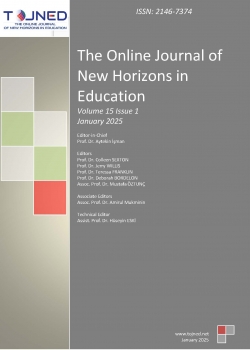TOJNED - Volume 15 - Issue 1 - January 2025
 EFFECT OF EMPLOYEE SATISFACTION LEVEL ON ORGANIZATIONAL COMMITMENT
EFFECT OF EMPLOYEE SATISFACTION LEVEL ON ORGANIZATIONAL COMMITMENT Aykan Osman Demir, Mustafa Vurucu, Azmiye Yinal
Abstract:
The main purpose of this research is to examine the effect of employee satisfaction levels on organizational commitment. The study aimed to analyze the relationships between employee satisfaction levels and organizational commitment. In this direction, quantitative research method was used and relational screening model, which allows examining the relationships between variables, was adopted as the research model. In the data collection process, personal information form was used from the participants, Minnesota Job Satisfaction Scale was used to measure employee satisfaction and Organizational Commitment Scale was used to determine organizational commitment levels. While Minnesota Job Satisfaction Scale measures employee satisfaction levels in two dimensions as intrinsic and extrinsic satisfaction; Organizational Commitment Scale evaluates commitment levels in three dimensions as affective commitment, continuance commitment and normative commitment. The obtained data were analyzed using SPSS 26.0 program for statistical analysis.
The results of this study show that employee satisfaction has a significant and strong effect on organizational commitment. As the levels of intrinsic satisfaction, extrinsic satisfaction and general satisfaction increase, the organizational commitment of employees also increases. In particular, general satisfaction stands out as the most effective factor on organizational commitment, and it has been determined that intrinsic satisfaction has a positive effect on commitment. The study examined organizational commitment within the framework of emotional commitment, continuance commitment and normative commitment dimensions. Emotional commitment reflects the voluntary and affection-based commitment of employees to the organization; continuance commitment reflects the commitment arising from economic and social obligations; and normative commitment reflects the sense of moral responsibility. However, it has been determined that general commitment levels are low-medium. In the correlation analysis, strong and positive relationships were found between employee satisfaction and organizational commitment. According to the regression analysis, general satisfaction stood out as the variable with the strongest effect on organizational commitment.
 FACTORS AFFECTING OCCUPATIONAL HEALTH AND SAFETY AWARENES
FACTORS AFFECTING OCCUPATIONAL HEALTH AND SAFETY AWARENES Halil Ä°brahim Kurt, Azmiye Yinal
Abstract:
The main purpose of this study is to determine the factors affecting occupational health and safety awareness in workplaces in the Turkish Republic of Northern Cyprus. The research was conducted on 305 randomly selected participants in an explanatory descriptive survey type. In the study, participants' Occupational Health and Safety (OHS) awareness levels were evaluated on four sub-dimensions: general OHS awareness, occupational health education-communication, occupational health risk perception and total OHS scale. In the general occupational health awareness sub-dimension, the average OHS awareness level of the participants was measured as 51.59 points. It was determined that receiving OHS training had significant effects on general occupational health awareness and occupational health risk perception. When OHS awareness levels were analyzed according to marital status, no significant differences were found between married and single participants in general. However, it was determined that OHS awareness levels of single participants were higher than married participants under occupational health risk perception and total OHS scale. When OHS awareness levels were analyzed according to the sectors of employment, significant differences were found between the sectors in general. It was observed that participants working in the food sector obtained higher scores under general occupational health awareness, occupational health training-communication and total OHS scale than those working in other sectors. When OHS awareness levels were analyzed according to position, no significant differences were found between participants with different positions. Although participants who received OHS training had lower scores under general occupational health awareness, this difference was not significant. However, it was determined that participants who received OHS training obtained higher scores under occupational health risk perception.
 INTERACTIVE REFLECTION THROUGH UNDERSTANDING: WHY KNOWING YOUR STUDENTS IS KEY TO EXPERTISE IN TEACHING
INTERACTIVE REFLECTION THROUGH UNDERSTANDING: WHY KNOWING YOUR STUDENTS IS KEY TO EXPERTISE IN TEACHING Bahar GĂĽn
Abstract:
This study explores the concept of teacher expertise, focusing on the interactive reflection in which English language teachers engage in real time in their classrooms. An analysis was made of data collected from reflective conversations between three pairs of teachers, each pair made up of a lesser and a more experienced teacher. The study highlights the importance of a clear understanding of students as individuals as a key factor in effective teaching. The findings suggest that practical teacher deliberation and interactive decision-making play crucial roles in developing expertise in language instruction. Additionally, the study provides implications for both pre-service and in-service teacher education programs, providing support for current trends that emphasizes the need for reflective practices and student-centered approaches.
 INVESTIGATION OF ARTICLE PUBLICATIONS ON LEADERSHIP STYLES BETWEEN 1993-2023 WITH CONTENT ANALYSIS
INVESTIGATION OF ARTICLE PUBLICATIONS ON LEADERSHIP STYLES BETWEEN 1993-2023 WITH CONTENT ANALYSIS Burak Demi, Tolga Ă–z, Azmiye Yinal, Mert Ă–mĂĽrlĂĽ
Abstract:
The purpose of this research; The articles published on "Leadership Styles" between 01.01.1993 and 31.12.2023 were evaluated by content analysis of the publications. In this context, the second aim of the research is; The second purpose of the research is to determine the status of research on "Leadership Styles" in the literature, to reveal the deficiencies and to contribute to researchers who want to work in this field. Google Academy and DergiPark databases were used to achieve the goal of the research. In line with the criteria determined in the research, 60 article publications were included in the research. As a result of the analysis conducted in the research, the most articles on leadership styles in the last 30 years were published in 2022 (f = 11; 18.3%), the publications were mostly written in Turkish (f = 52; 86.7%), and although the publications were generally equally distributed in the journals, the most There were slightly more publications in journals such as Ä°nönü University Faculty of Education Journal (f=4; 6. 6%) and Journal of Education in Theory and Practice (f=4; 6.6%), and the study areas of the article publications were mostly in the field of education (f=52; 86.7%). Quantitative (f=58; 96.7%) research method was used in almost all of the publications, survey models (f=43; 71.6%) were used in the majority of publications, and typical case sampling (f=16; 26.6%) was mostly preferred in article publications. , in the publications, mostly teachers (f=38; 63.2%) constitute the sample groups and the sample sizes mostly vary between 201-400 (f=22; 36.7%). In article publications, mostly survey/scale (f=58; It was concluded that data collection tool (96.7%) and SPSS (f=58; 97.7%) data analysis programs were used.
 INVESTIGATION OF EMPLOYEES' PERCEPTION LEVELS TOWARDS THE STRATEGIC MANAGEMENT PROCESS AND ORGANIZATIONAL CYNISM
INVESTIGATION OF EMPLOYEES' PERCEPTION LEVELS TOWARDS THE STRATEGIC MANAGEMENT PROCESS AND ORGANIZATIONAL CYNISM Aykan Osman Demir, Azmiye Yinal
Abstract:
The main purpose of this study is to examine the perception levels of employees residing in the Turkish Republic of Northern Cyprus (TRNC) towards strategic management process and organizational cynicism. The population of the study consists of all employees residing in TRNC. The size of the sample consists of 393 people. The data collection tools used in the study include demographic information form, Organizational Cynicism Scale and Strategic Management Scale. SPSS 28 program was used to analyze the data. The findings show that the participants are generally moderately involved in the strategic management process. In the resource dimension, the level of involvement was found to be moderate, while in the environment dimension, this involvement was slightly higher. The general perception of strategic management is distributed in a wide range among the participants and is at a medium level on average. In terms of organizational cynicism perceptions, it was determined that the participants' cognitive, affective, and behavioral cynicism perceptions ranged from low to medium. It was determined that cognitive cynicism and behavioral cynicism perceptions were between low and medium, while affective cynicism perception was at lower levels. The perception of general organizational cynicism is similarly distributed in a wide range and is at a medium level on average.
 THE EFFECT OF BANK IMAGE ON CUSTOMER PERCEPTION TRNC EXAMPLE
THE EFFECT OF BANK IMAGE ON CUSTOMER PERCEPTION TRNC EXAMPLE Murat Aslan, Mehmet Çağlar, Azmiye Yinal
Abstract:
This study was conducted to determine the customer image of a bank operating in the Turkish Republic of Northern Cyprus. The study was conducted within the framework of a relational survey model using a quantitative approach and included 369 respondents from a population of 2000 bank customers. As a data collection tool, the scale developed by KalyoncuoÄźlu and Faiz (2016) was used to measure service quality and corporate image. According to the findings of the study, customer evaluations show that service quality has a positive effect on corporate image, especially in the dimensions of Physical Assets, Reliability, Responsiveness, Assurance, and Identification. In the Physical Assets dimension, customer evaluations are generally high and consistent. However, a wider variation was observed in the Reliability dimension. Customer evaluations in the dimensions of Responsiveness, Assurance and Identification show moderate consistency. Correlation analysis reveals that there are positive and significant relationships between the Physical Assets, Reliability, Responsiveness and Identification dimensions and Corporate Image. However, the relationship between the Assurance dimension and Corporate Image shows a weaker link. The regression analysis results show that each service quality dimension (Physical Assets, Reliability, Responsiveness, Assurance, and Identification) has a positive effect on corporate image. This emphasizes the importance of focusing on service quality for banks to strengthen their corporate image by increasing customer satisfaction.
 THE EFFECT OF LEADERSHIP STRUCTURE ON EMPLOYEE PERFORMANCE
THE EFFECT OF LEADERSHIP STRUCTURE ON EMPLOYEE PERFORMANCE GĂĽlden Bozat, Azmiye Yinal
Abstract:
The purpose of this study is to examine the effect of leadership structure on employee performance in banks. The study was conducted using the survey technique, which is one of the quantitative research methods. The population of the study consisted of employees working in banks in TRNC and the sample consisted of 247 employees. Data were collected through a scale. The scale used consists of 3 parts. In the first part, personal information form prepared by the researcher, in the second part, Perceived Leadership Style Scale developed by House and Dessler (1974) and in the last part, job performance scale developed by Darwish (2000) were used.
According to the findings of the study, it was observed that men scored higher in the participative leadership dimension and individuals who worked longer in the directive leadership dimension. In addition, it was determined that certain age groups and married individuals obtained higher scores in participative leadership. A significant relationship was found between professional seniority and leadership style. It was observed that participants with less professional seniority achieved higher scores in certain leadership styles. In terms of job performance, it is noteworthy that certain demographic groups have higher scores. In addition, while participative leadership had a significant effect on job performance, directive leadership and perceived leadership style had no significant effect on job performance. As a result, it was determined that demographic factors and leadership styles, especially participative leadership, and professional seniority influence job performance. According to the results, there is a negative relationship between participative leadership and job performance. On the other hand, no relationship was found between perceived leadership style and job performance.
 THE EFFECT OF MOBBING ON EMPLOYEE PERFORMANCE: A RESEARCH ON BANK EMPLOYEES
THE EFFECT OF MOBBING ON EMPLOYEE PERFORMANCE: A RESEARCH ON BANK EMPLOYEES Hakan Aşık, Azmiye Yinal
Abstract:
The aim of this study is to examine the effect of mobbing on employee performance. In this context, the study was conducted using the survey technique from quantitative research methods. The population of the study consisted of bank employees in TRNC and the sample consisted of 247 bank employees. The data were collected using the Psychological Violence Inventory (LIPT) developed by Davenport et al. (2003) and the Performance Scale used by ÇorbacıoÄźlu (2018) and analyzed using SPSS 28 software.
The study showed that male respondents generally scored higher than female respondents on certain dimensions of psychological violence. This suggests that men may be more likely to experience psychological violence in dimensions such as self-expression, restriction of communication opportunities, attack on social reputation and attack on professional status. Analyses between different age groups at the end of the study showed that there were significant differences in certain dimensions of psychological violence. For example, while 20–30-year-olds may be affected in a different dimension than 31–42-year-olds, the 31-42 age range was more affected than other age groups. Also, participants aged 43 years and older were more affected than those aged 31-42 years. Differences between married and single participants are particularly evident in the dimension of "Restriction of self-expression and communication opportunities". Single participants scored higher in this dimension, while married participants scored higher in other specific dimensions. The study showed that mobbing differs in various dimensions of psychological violence according to professional seniority. The study reveals that there is no direct relationship between employee performance and gender, age, and marital status, but professional seniority has a significant impact on performance.
The research shows that there is a certain relationship between employee performance and psychological violence inventory and its sub-dimensions. "Restriction of opportunities for self-expression and communication", "Attack on social reputation" and "Psychological Violence Inventory (General)" dimensions have a positive and strong relationship with performance, while "Attack on quality of life and professional status", "Attack on social relationships" and "Direct attack on health" dimensions have a moderate positive relationship with performance. Research results show that different psychological violence sub-dimensions have varying effects on employee performance. The dimension of "Assault in social relationships" was found to negatively affect performance, suggesting that aggressive behaviors that employees are exposed to in their social relationships may negatively affect their performance. Another finding is that the "Psychological Violence Inventory" has a positive effect on performance. It is suggested that individuals who experience general psychological violence may show higher performance.


